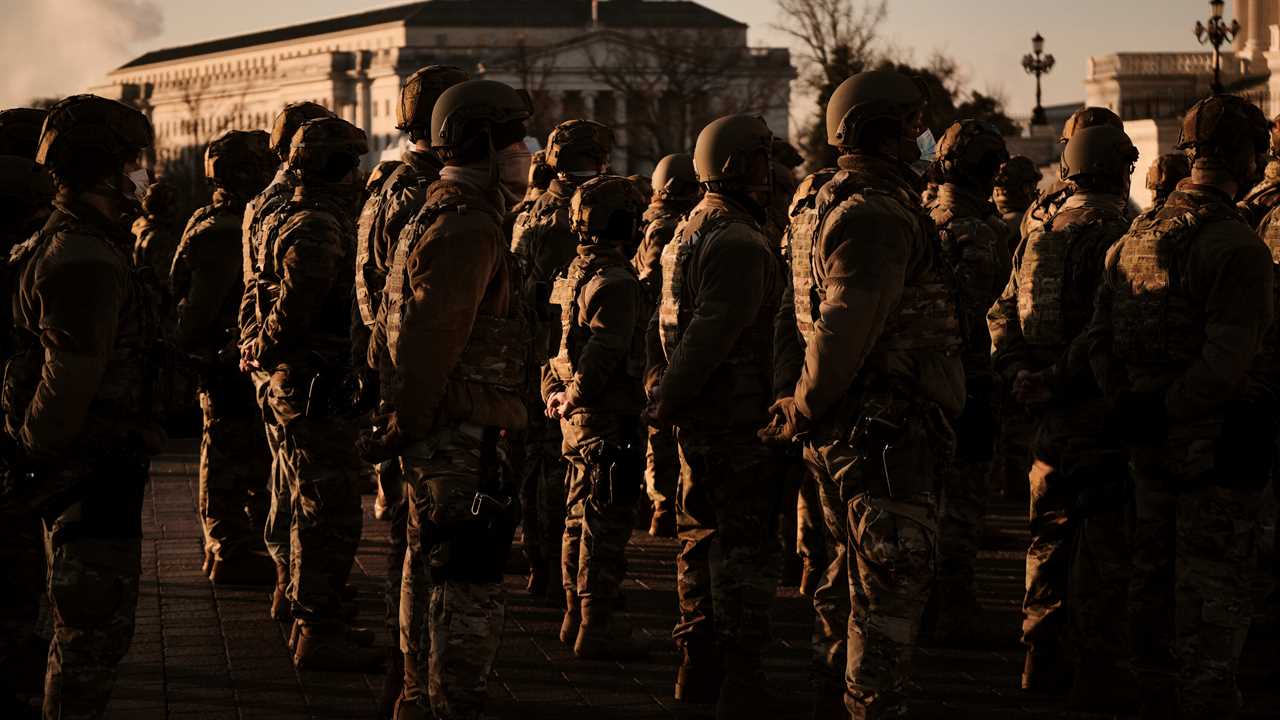
WASHINGTON — In deciding to arm the National Guard troops assigned to the Capitol complex for President-elect Joseph R. Biden Jr.’s inauguration, the Defense Department crossed a Rubicon that for the last six months Pentagon officials have tried to avoid: potentially pitting armed military forces against American citizens in the streets.
History has shown that such events never go well, senior Defense Department officials said on Wednesday, citing Kent State in 1970, Tiananmen Square in 1989 and Tehran in 2009.
In Washington, the most famous military confrontation with American citizens dates to 1932, when President Herbert Hoover ordered Army troops to clear more than 40,000 people — many of them veterans from World War I demanding cash compensation from the government for their service — from campsites all over Washington, including on the same ground the National Guard is now occupying. The intervention proved a political disaster for Hoover, who lost the presidential election later that year.
But now, after a violent pro-Trump mob that included white supremacists and neo-Nazis stormed the Capitol last Wednesday, overwhelming the limited number of police officers on hand, the Pentagon is going where before it feared to tread. And it is some of the very same people — Democrats — who have in the past warned against a muscular response to past protests, now pushing for an armed military.
As the Secret Service prepares to shut downtown Washington days earlier than first planned, the acting police chief in Washington, Robert J. Contee III, announced Wednesday that an additional 5,000 National Guard troops would be deployed to the city to support local law enforcement providing security for Mr. Biden’s inauguration, bringing the total number of Guard personnel to 20,000.
That is roughly three times the total number of American troops deployed in Iraq, Afghanistan, Somalia and Syria.
More than 3,000 National Guard troops, rotating in 12-hour shifts, will provide security in and around the Capitol at any given time. Other troops will help control traffic and Metro stations elsewhere in the city. Members of the Guard at the Capitol will be equipped with M9 sidearms and some will carry automatic rifles and shotguns. All will have protective riot gear, including helmets and Kevlar vests, Guard officials said.
During the Black Lives Matter protests over the spring, law enforcement officials expressed concern that the police and National Guard troops had inadequate time to coordinate and fully understand the complicated chains of command in Washington’s overlapping local and federal jurisdictions.
How the influx of National Guard from all over the country — nearly three times as many as the initial inauguration planning — efficiently fold under the Secret Service will test the command structure’s effectiveness, current and former federal officials said.
Top officials from the Secret Service and the Pentagon, including Gen. Mark A. Milley, the chairman of the Joint Chiefs of Staff, as well as from other agencies were scheduled to meet on Wednesday and on Friday to review measures like aerial and maritime security, countersurveillance as well as the National Guard’s missions.
Latest Updates
- Federal authorities warn that the Capitol breach will be a ‘significant driver of violence.’
- F.B.I. and U.S. officials urge police chiefs to be prepared and share intelligence.
- She saw her mother at the Capitol melee and called her out — publicly.
One former top law enforcement officer emphasized the need for good planning and coordination before possible protests on Sunday and Inauguration Day next week, noting that the goal of the police and National Guard should be “prevention and de-escalation” of any violence.
One official not directly involved in the planning this week was the acting secretary of defense, Christopher C. Miller, who is on a three-day trip to visit the military’s Strategic Command in Nebraska (which oversees the Pentagon’s nuclear arsenal), the Northern Command in Colorado (which oversees the military’s support for domestic defense), and Special Operations forces at Fort Campbell, Ky.
Mr. Biden’s top advisers went to F.B.I. headquarters on Wednesday to meet with its top officials and the Secret Service, about possible threats and the protection plan, according to one senior transition official. The delegation was led by Jake Sullivan, Mr. Biden’s incoming national security adviser.
Among the preparations are making sure that agencies that have no Senate-confirmed leaders — including the Department of Homeland Security — understand who the acting officials are when Mr. Biden takes office next week. Mr. Sullivan, aides said, has asked for detailed plan on what happens “between 11:59 a.m. and 12:01” on Jan. 20, in case events unfold during Mr. Biden’s oath-taking, or the inaugural address.
The planning has gone beyond Washington, officials say, as Mr. Biden’s aides try to understand the plans for the capitals of all 50 states, where there is also fear of violence or attacks on State Capitol buildings or federal facilities.






